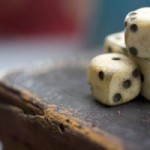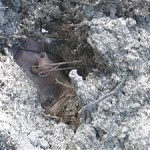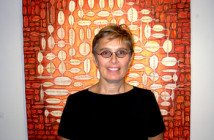Mary Ellen Strom: The Nudes
Judi Rotenberg Gallery
Through May 7
Corporate Commands
Space 200
Through April 29
Denise Marika: Detritus
Howard Yezerski Gallery
Through May 24
Some time back we wrote a Beer and Burger piece on Cyberarts Festival director George Fifield. Through May 8 that annual event is in full swing. One would need seven league boots to get to all of the events but right now I am about as ambulatory as Red Sox starting pitchers, Curt Shilling and David Wells. Which is to say not at all. There is nothing wrong with my wheels, just bad timing. There are a ton of openings tonight that I will miss because of a makeup, snow cancellation date at U. Mass Lowell. Believe me I would rather be dishing and trashing at the DeCordova “Annual,” schmoozing at Gallery Naga, or commiserating (more on that in a moment) at Space 200. Or any number of other hip happenings around town. It is the end of the semester with the usual student meltdowns.
Between classes the other day I dashed off for a glimpse of the latest offerings on Newbury Street. It was remarkable to find not one, but, good heavens, two video installations. Of course this is nothing notable in Chelsea but for Boston? Incredible. But, truth is, both spaces, Howard Yezerski and Judi Rotenberg, have long term commitments to new media.
Over a number of years, Denise Marika, a professor at Mass. College of Art, has been one of the most challenging artists represented by Yezerski Gallery. The work has been shown extensively in the area most notably in a project with the Isabella Stewart Gardner Museum.
In the darkened gallery is a large projection framed by steel girders. Beneath the image is a narrow mirror. If you are standing close to the work it seems to sink into the floor. On the other end of the gallery is a small screen mounted on the wall. The large image is projected from under the gallery bench behind which is an enormous stack of the current issue of Boston’s Weekly Dig, an alternative youth/ entertainment tabloid. There is a still from her “Detritus” on the cover as well as an eight page, centerfold portfolio. It represents ambitious support for the publication which appears to be making a serious commitment to the arts. Visitors to the exhibition are invited to take home a copy of Dig so the installation will become depleted. There is a small, limited edition of the portfolio which will represent the documentation of the event.
The commitment of the publication to this project is all the more significant because of the difficult, inaccessible nature of the work. The cover, an image of the yellow arm of a crane bearing the text “Costel” which we assume to be a fragment of the company, Costello, is razing a building. Readers of Dig will no doubt conclude that the cover story is somehow related to the Big Dig. Kind of an in joke. But Marika is not an artist noted for humor or irony.
There is a daunting austerity to her oeuvre which often involves her nude body in obsessive-compulsive, repetitive, ersatz calisthenics. Yes, it is a nude woman’s body but somehow drained of its sexuality. It clearly does not arouse this male’s gaze. The body, which is pouring some ash over itself, is barely discernible through an over layer of progressive razing of a building. The process results in the detritus which is the title of the project.
At the other end of the gallery, in the smaller screen, it was pointed out to me, hardly evident at first glance, that in the 13 minute loop, the artist is eating away a layer of dirt to reveal a barely recognizable view of her face. This reminded me of a stunt on Fear Factor, one of my least favorite TV programs. Indeed, I wonder just why Marika is always putting her body, heart, mind and soul through such adversity? While pushing herself to extremes she is also testing the limits of the viewer. While I greatly respect the seriousness of the work, I am concerned about my role as a voyeur of such masochistic activity. For me it is an uncomfortable experience which may be the intention of the artist.
By contrast, the nude women in the video projects of Mary Ellen Strom at Judi Rotenberg Gallery are served up straight no chaser. Much more palatable, but, perhaps, less challenging, to this male’s gaze. The twister is that the artist is appropriating and riffing on, deconstructing to use a slicker term, a series of Old Master paintings. She has created a series of tableaux vivants. The women are posed so as not to move, or very little. It is that restrained body language and occasional twitch that informs us that this is video not still photography. It is a trope that has become a cliché in the video works of artists from Bill Viola to Gillian Wearing, which leads one to ask why not just exhibit a still photograph? Is the art all in the movement? And through endless repetition hasn’t the trick/trope/cliché devolved to become rather enervating? But the old House of Wax trick is ubiquitous. Visitors to the Damien Hirst bric-a-brac that curator Cheryl Brutvan slapped together for the MFA have oohed and aahed over the fact that the scientist, in a life-sized vitrine with live butterflies, appears to be breathing and slowly turning the knob of a microscope. It makes one want to shriek the famous line from the “Bride of Frankenstein.” “It’s alive. It’s alive.” Big deal.
Strom’s videos work best when dealing with an icon such as the Velasquez “Venus with a Mirror.” The painting by the Baroque master is all the more famous because of the rarity of the nude in that period of Spanish art. Discretely we view her supine form from the rear. A cupid props up a mirror for Venus to view her face. There is not a hint of a breast. So Velasquez managed a rather chaste and coy nude.
The less familiar subjects do not work as well. A reclining woman with her head propped up by a bent arm has a framed rectangle with a “live” view of the ocean above and behind her. It references a Magritte I have never seen. Ditto “Danae” by the Italian Baroque artist, Orazio Gentileschi, or an obscure work by Manet, “The Surprised Nymph.” Because of the factor of recognition the Velasquez based piece worked best for me. The other works, while engaging, were too much of a stretch.
Over a beer and burger the other night with curator James Manning, he was a bit in a funk. He had been flat out all week installing several Cyberarts shows. But after pulling an all-nighter to set up the show he curated at Space 200 he arrived the next day to find that it had been taken down by the new management of the tall office building which is steps from popular Quincy Market. After lengthy negotiation, including some intervention by Fifield, the show opened, as scheduled, from 6 to 9 pm - then taken down. I regret that I will be unable to attend Manning’s curatorial swan song for Space 200. Hic transit Gloria mundi.
Todd McKie: Paintings
Gallery Naga
Through May 21
With this first one person exhibition at Gallery Naga, a veteran of the Boston art world, Todd McKie, returns to Newbury Street. For many years he showed in the private home/gallery of the late Cambridge based art dealer, Barbara Singer. While he showed regularly there was limited visibility of the work. In the past couple of years he has shown with Victoria Munroe Gallery. She started here with Impressions Gallery then ran a New York gallery that closed some time back. Munroe recently returned to Boston with a space at 59 Beacon Street. She specializes in works on paper and will continue to represent that aspect of McKie’s work.
Whimsy is currently a major aspect of the work of emerging artists. In that mode McKie should be regarded as a master and elder statesmen. Who knew, decades ago when we howled at the work and stunts of McKie and his partner, Marty Mull, the other half of the Smart Duckys (today represented by Spike Gallery in Chelsea) that they would prove to be so influential. Nowadays, the kids just wannah have fun. But back then, everyone (remember Clement Greenberg and all that?) was so damned serious. Todd and Marty were really sticking their necks out for a few laughs. Like when they rocked the stodgy old MFA by staging a guerrilla exhibition of their work in the elegant epic, marble walled, men’s room of the MFA. Diggery Venn, an uptight old coot, freaked when he wandered in to take a leak and found men and, good heavens, women having a blast for the opening of “Flush with the Walls.” The rest as they say is history.
But this delightful and witty show answers the question of so, what have you been up to lately? A lot it would appear. The paintings are so fresh and timely they could have been churned out by some twentysomething MFA grad. But with a depth, richness and sophistication that demands time to perfect. While these works show McKie at his peak it is curious that it has taken the art world all this time to catch up.
These “late” works reveal that less is more. They are sly, wry and reductive. My favorite is “A Proud Tradition.” There is a curious “dead” man lying on the ground in profile with one leg kicking up. Perhaps a last gasp. His black head is dismembered and face front, parallel to the body. That is anatomically impossible but makes sense graphically. The head has a kind of carved out pumpkin simplicity with a silly grin and big gaping holes for eyes. There is a flat, textured, all over blue background with blotchy passages of white suggesting clouds. A single daisy is descending. Perhaps an ersatz coup de grace of some unseen perp as they say in the cop shows. There is a hint of the tragic but edged to bathos. Surely there has been darkness in the artist’s life but also the epic ability to convey fits of gallows’ humor.
If as Betty Carter would croon “Spring can hang you up the most” then you owe it to yourself to hang out with this show. Exit laughing.
Olivia Parker
Robert Klein Gallery
Through April 30
These large format digital prints by Olivia Parker, one of America’s foremost still life photographers, are simply stunning. One may track the history of the technology of the medium through her work over several decades. She started as a black and white photographer creating crisp, richly toned images. There was a period when she introduced shadows into the pieces by placing objects outside the picture frame; either found pieces or silhouettes that she created. Gradually color wias introduced and to scanned in rolls of film. There was a transition from the darkroom to digital work and computers.
In this new work she appears to be in top form and the labels indicate that she is doing her own printing on sheets up to 24" in width. This is an expensive and labor intensive process but gives the artist complete control. In an earlier phase she was creating Iris prints with Graham Nash. The development of the Epson line of printers has liberated artists but mandated a steep learning.
The iconography of the artist, her catalogue of objects, has never been more reductive. In this show - a single antique die carved from marble, a detail of an aged bottle with a wonderful patina, a broken shell - are rich with meaning and understated anecdote. Her most baroque piece finds a rotting red potato with monstrous sprouts set on a table against an out of focus ornate, gold carved room. It could evoke the sad demise of Marie Antoinette and the fall of the Ancien Regime. Or just be an old spud.
Gil Mares: Harbor Abstracts
Kidder Smith Gallery
Through April 30
What first appears to be slickly mounted, glossy, richly colored abstract photography by California based artist, Gil Mares, is apparently not. Abstract. They are in fact images of the water lines of ships. It takes some time to intuit that although the occasional anchor should clue you in. But in some the images a field of color and narrow band of blue water does not readily compute. Arguably, the point and triumph of this sumptuous work. Yes, beauty, gorgeousness. That’s the rub. The signature and logo of work presented by gallerist, Tom Smith. He is fixated on feasts for the eye; an obsession with the visual and sensual. I wonder when Tom, as Duchamp would say, will show work that is a bit less retinal. The truth is we that all enjoy beauty, but is there truth in beauty? Come on, be honest. Pretty please?
- Olivia Parker, Dice, color photograph. On view at Robert Klein Gallery.
- Todd McKie, A Proud Tradition, flashe on canvas, 2005. On view at Gallery Naga.
- Denise Marika, Gnaw, still from video installation, 2005. On view at Howard Yezerski Gallery.
Links:
Judi Rotenberg Gallery
Howard Yezerski Gallery
Isabella Stewart Gardner Museum
Boston’s Weekly Dig
Gallery Naga
Robert Klein Gallery
Kidder Smith Gallery
All images are courtesy of the artist and the respective venue.







